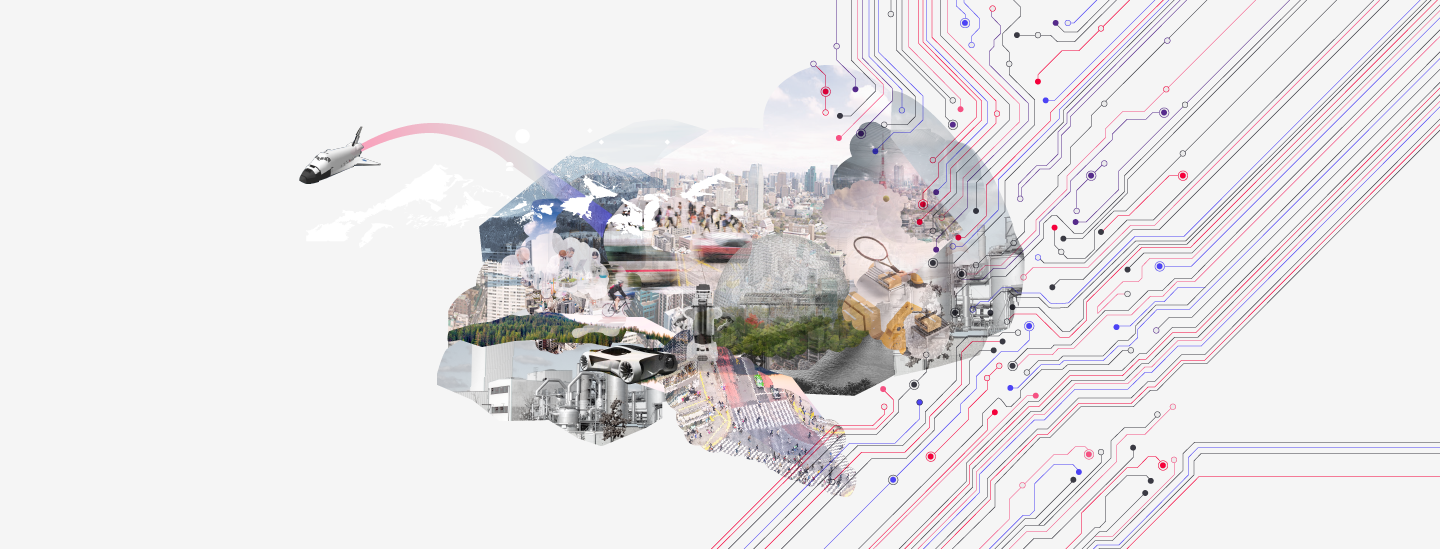The next wave of digital transformations
The World Wide Web began a technological and cultural revolution in 1989. E-commerce, social media and mobile Internet have since then radically changed our daily lives and the way business is done. Hindsight could lead to the erroneous conclusion that the success story of digitalisation has already reached its conclusion. Are the central claims located on the Net? Will it be simply 'more of the same' from now on?
Just the opposite. It is likely that the digital transformation of business and society is just beginning. New technologies, which are growing more rapidly and converging, are being developed all the time, sometimes with breathtaking speed. Their disruptive effects have already been felt in some sectors, where they call traditional business models into question and open up new markets, creating new winners and new losers.
The biggest thing in the next twenty years will be the completion of pervasive computing. Vision, speech, handwriting, googles, every surface, infinite machine learning, infinite storage, infinite reliability, at essentially no cost. Bill Gates in Wired, 16.04.2014
Yet, networking continues to grow exponentially, at the global, local and microlocal level; and it is set to end with an IT ‘super convergence’. The Net of the future will link people with people, things and machines with other things and machines, people with things and machines, and vice versa. It will result in an ‘Internet of Everything’ – with far-reaching effects.
The juxtaposition of the physical, tangible reality and a cyberspace into which we can peer only by means of display screens, as if through the windows of a sweet shop, is disappearing. Cyberspace is expanding into the offline world, affecting everyday objects, bringing data sets into our surroundings. Reality is not only extending its reach, its very fabric is also becoming more digital.
Trends and Drivers of Connected Reality
The super convergence in information technology sector is driven by increased networking, miniaturisation and the improved performance of processors, memory stores and sensors. This development is reflected in five technological trends.
The super convergence in information technology sector is driven by increased networking, miniaturisation and the improved performance of processors, memory stores and sensors. This development is reflected in five technological trends.
- Internet of Things. The Internet of Servers is being expanded to create an Internet of Things, to which machines, equipment and products are also linked.
- Ubiquitous intelligence. The information that they produce and which is processed in the cloud using Big Data methods integrates new characteristics and services into our surroundings, creating a ubiquitous intelligence.
- New interfaces. New interfaces such as goggles (optical head-mounted displays), which represent the next qualitative development after smartphones, will enable rapid and direct use of this new technology. They will open up augmented-reality applications for the mass market in the next decade.
- Digital production. The further development of 3D printing and other decentralised manufacturing techniques is shortening the path from virtual design to physical realisation. Smaller, faster networks are competing with large-scale production units; cyber-physical systems are preparing to revolutionise industry. Efficient digital production is on the rise.
- Autonomous systems. It is supported by autonomous systems, such as intelligent manufacturing robots and software agents.
These technological trends go hand-in-hand with social innovation drivers.
- Digital lifestyle. The digital lifestyle, which has, up to now, been characterised by the consumption of new media content and network communication, is becoming more intense.
- New spirit of autarchy. Health and fitness are moving into the field of vision, but so too is the exchange of products and services in the ‘sharing economy’. More and more consumers are using new tools to discover the desire to do things themselves, a new spirit of autarchy is challenging manufacturers and service providers.
- Real-time economy. They, in turn, are setting the pace at which they sell to clients in the real-time economy, not just for products but also new services.
- Resource efficiency. These drivers, which affect business and society, are challenged by two requirements, both of which necessitate innovation. Climate change and the threat of raw material shortages mean greater resource efficiency is required.
- Security. Whilst the continuing rise in cybercrime, the potential threat of terrorism, as well as a greater aversion to risk in our daily lives, all demand more security.
Not all these trends are new. Some of them having been talked about for decades. MIT has been conducting research into the Internet of Things and ‘things that think’ since the early 90s. Scenarios modelling ‘ambient intelligence’, that is to say, a highly-networked intelligent everyday world, were already the subject of a major EU project at the end of the last millennium. What is new, however, is the sudden increase in development speed, resulting from a change in the social context and the level of maturity of key technology markets. IT – having taken over our desks, our trouser pockets and, increasingly, even our living rooms over the last few decades – now has the rest of the world in its sights.
A new operating system
The more digital networking takes hold of all aspects of our lives and all types of commercial transactions, the more it becomes a fundamental part of our daily reality – a changed reality, in which future generations will not be able to understand how it was possible to live with ‘stupid things’ that weren’t permanently linked to the Cloud, nor how we managed to survive without goggles and information-forecasting services. These words do not depict a distant future, rather they describe a trend that began long ago and which will change, over the next few decades, not only our daily lives and value-creation processes, but also our concept of reality itself.
Holding connected reality out as an example of the transformational power of the super-convergence of information technology is just as bold as it is vague. All too often, developments are heralded as the next big thing set ‘once again to change everything’. On the other hand, innovations in information technology – from the telephone via the Internet to the smartphone – always have a profound effect on the social and economic ‘operating system’.
The emergent super-convergence of information technology has the potential not only to update but also to introduce a completely new operating system, which will redefine our expectations of, and our dealings with, the things, devices and spaces that surround us.
If, in a few years, we have become used to the constant availability of information about people, situations and things in our immediate surroundings thanks to technology about our person – so-called wearables, and if it has become the norm for intelligent products, houses and vehicles to ‘recognise’ us and to use networked services to cooperate and anticipate our requirements, then a world in which these magic properties are lacking will soon seem very strange to us. Welcome to connected reality.
What connected reality means for businesses
The interplay of innovation drivers is already apparent. For example, augmented lifestyles, new interfaces and the real-time economy are creating hybrid shopping opportunities that remove the boundary between traditional and online shopping; and, ubiquitous intelligence, Big Data and security requirements are forcing international companies to adopt cloud-based working practices for their projects. There are numerous trend indicators that show that super-convergence is imminent. Connected reality will set new parameters for businesses. Thus, value is increasingly being created in networks through the use of hyper-connectivity.
- Key Players: Business ecosystems. The importance of individual companies is disappearing: connected reality means the key players will actually be ‘business ecosystems’.
- Competition: The new power of integrators. Manufacturers and service providers will offer complex solutions to customers’ requirements, e.g. the use of wearable sensors in the field of smart health, providing cloud-based data analysis, medical diagnosis and nutritional advice that will make it possible for health to be monitored intensively in real time. However, within business ecosystems, even former competitors will come to collaborate; for example, car manufacturers and transport operators, such as train companies, will use data integrators to link their products instead of trying to entice customers away from one another.
- Markets: Cross-sector markets. Thus, traditional market boundaries will begin to disappear, giving rise to new cross-sector markets. To enable these new markets to develop, system innovations will be required – not to improve individual product parameters, but rather to build application contexts from the bottom up. The economy must, therefore, adopt a new culture of openness, going as far as open innovation and open collaboration. These will become an essential and self-evident part of business life in connected reality. Markets will no longer be characterised as battlefields, where as much ground as possible must be won. Instead, they will become spheres of cooperation where it is possible to come up with appropriate solutions amongst the constant flow of data and information and in conjunction with customers and other operators.
- Innovation: System Innovation. This creates a multitude of new challenges for businesses. Products that can be networked will generate a continuous stream of data, and new ways of creating value based on that data will have to be developed in order to generate added value from the data. Customer relations will come to be characterised more and more by real-time interaction. Increasingly, products and services will need to be developed and marketed as hybrid bundles. It will be necessary to open up the potential for smart automation along the entire value-creation chain.
We can already see all these developments in use today; each one is the subject of numerous strategic discussions and management consultancy studies. Yet, as the pace of change becomes greater, the more important it becomes to evaluate the various trends and future developments in the round in order to gain sight of the big picture. This overview can then be used to guide strategic focus. This study represents a first step along this path.



